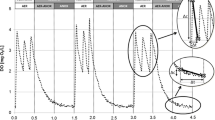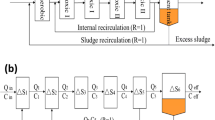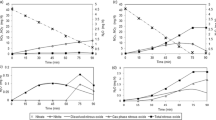Abstract
This study attempted to elucidate the effects of ammonium and salinity concentrations on Nitrous Oxide (N2O) emission in a partial nitrification system producing an influent suitable for the anammox process. 1.2%, 1.3% and 1.0% of the incoming nitrogen load was emitted as N2O-N during the batch partial nitrification with 200, 300 and 400 mg L−1 NH4 +-N, respectively. N2O emission increased with the increase of ammonium concentration and the load in the wastewater due to the high values of the nitrite and ammonium. 1.5%, 1.6%, 1.8% and 1.9% of the incoming nitrogen load was emitted as N2O-N during the batch partial nitrification with 2, 4, 6 and 8 wt% NaCl, respectively. N2O emission increased with the increase of salinity concentration in the wastewater as the result of inhibition of nitrous oxide reductase activity. The dynamic behavior of N2O emission (quantity (y) varying with time (x)) in the partial nitrification process can be fit to the line where y = ax + b under different ammonium and salinity concentrations.
Similar content being viewed by others
References
Ahn, J. H., Kim, S., Park, H., Rahm, B., Pagilla, K., and Chandran, K. (2010). “N2O emissions from activated sludge processes, 2008–2009: Results of a national monitoring survey in the United States.” Environmental Science & Technology, Vol. 44, No. 12, pp. 4505–4511, DOI: 10.1021/es903845y.
APHA (2005). Standard methods for the examination of water and wastewater 21st ed., American Public Health Association, Washington DC. USA.
Campos, J. L., Mosquera-Corral, A., Sánchez, M., Méndez, R., Lema, J. M. Campos, J. L., Sánchez, M., Mosquera-Corral, A., Méndez, R., Lema, J. M., Hu, Z., Lee, J. W., Chandran, K., Kim, S., and Khanal, S. K. (2012). “Nitrous Oxide (N2O) emission from aquaculture: A review.” Environmental Science & Technology, Vol. 46, No. 12, pp. 6470–6480, DOI: 10.1021/es300110x.
Hu, Z., Zhang, J., Li, S., and Xie, H. (2013a). “Impact of carbon source on nitrous oxide emission from anoxic/oxic biological nitrogen removal process and identification of its emission sources.” Environmental Science and Pollution Research, Vol. 20, No. 2, pp. 1059–1069, DOI: 10.1007/s11356-012-1018-6.
Hu, Z., Zhang, J., Xie, H., Liang, S., and Li, S. (2013b). “Minimization of nitrous oxide emission from anoxic-oxic biological nitrogen removal process: Effect of influent COD/NH4 + ratio and feeding strategy.” Journal of Bioscience and Bioengineering, Vol. 115, No. 3, pp. 272–278, DOI: 10.1016/j.jbiosc.2012.09.016
IPCC (2007). Climate change 2007: The physical science basis, IPCC, Parisl
Jia, W., Zhang, J., Xie, H., Yan, Y., Wang, J., Zhao, Y., and Xu, X. (2012). “Effect of PHB and oxygen uptake rate on nitrous oxide emission during simultaneous nitrification denitrification process.” Bioresource Technology, Vol. 113, pp. 232–238, DOI: http://dx.doi.org/10.1016/j.biortech.2011.10.095
Jia, W., Liang, S., Ngo, H., Guo, W., Zhang, J., Wang, R., and Zou, Y. (2013). “Effect of phosphorus load on nutrients removal and NO emission during low-oxygen simultaneous nitrification and denitrification process.” Bioresource Technology, Vol. 141, pp. 123–130, DOI: http://dx.doi.org/10.1016/j.biortech.2013.02.095
Kampschreur, M. J., Temmink, H., Kleerebezem, R., Jetten, M. S. M., and van Loosdrecht, M. C. M. (2009). “Nitrous oxide emission during wastewater treatment.” Water Research, Vol. 43, No. 17, pp. 4093–4103, DOI: http://dx.doi.org/10.1016/j.watres.2009.03.001
Kim, D.-J., Lee, D.-I., and Keller, J. (2006). “Effect of temperature and free ammonia on nitrification and nitrite accumulation in landfill leachate and analysis of its nitrifying bacterial community by FISH.” Bioresource Technology, Vol. 97, No. 3, pp. 459–468, DOI:10.1016/j.biortech.2005.03.032.
Kim, S.-W., Miyahara, M., Fushinobu, S., Wakagi, T., and Shoun, H. (2010). “Nitrous oxide emission from nitrifying activated sludge dependent on denitrification by ammonia-oxidizing bacteria.” Bioresource Technology, Vol. 101, No. 11, pp. 3958–3963, DOI: 10.1016/j.biortech.2010.01.030.
Kong, Q., Liang, S., Zhang, J., Xie, H., Miao, M., and Tian, L. (2013a). “N2O emission in a partial nitrification system: Dynamic emission characteristics and the ammonium-oxidizing bacteria community.” Bioresource Technology, Vol. 127, pp. 400–406, DOI: 10.1016/j.biortech.2012.10.011.
Kong, Q., Zhang, J., Miao, M., Tian, L., Guo, N., and Liang, S. (2013b). “Partial nitrification and nitrous oxide emission in an intermittently aerated sequencing batch biofilm reactor.” Chemical Engineering Journal, Vol. 217, pp. 435–441, DOI: 10.1016/j.cej.2012.10.093
Kong, Q., Zhang, J., Ngo, H. H., Ni, S., Fu, R., Guo, W., Guo, N., and Tian, L. (2013c). “Nitrous oxide emission in an aerobic granulation sequencing batch airlift reactor at ambient temperatures.” International Biodeterioration & Biodegradation, Vol. 85, pp. 533–538, DOI: 10.1016/j.ibiod.2013.04.005.
Li, H., Chen, X., and Chen, Y. (2010). “Effect of the addition of organic carbon sources on nitrous oxide emission in anaerobic-aerobic (low dissolved oxygen) sequencing batch reactors.” Frontiers of Environmental Science & Engineering in China, Vol. 4, No. 4, pp. 490–499, DOI: 10.1007/s11783-010-0248-4.
Li, C., Wang, T., Zheng, N., Zhang, J., Ngo, H., Guo, W., and Liang, S. (2013a). “Influence of organic shock loads on the production of NO in denitrifying phosphorus removal process.” Bioresource Technology, Vol. 141, pp. 160–166, DOI: http://dx.doi.org/10.1016/j.biortech.2013.03.117.
Li, C., Zhang, J., Liang, S., Ngo, H., Guo, W., Zhang, Y., and Zou, Y. (2013b). “Nitrous oxide generation in denitrifying phosphorus removal process: Main causes and control measures.” Environmental Science and Pollution Research, Vol. 20, No. 8, pp. 5353–5360, DOI: 10.1007/s11356-013-1530-3.
Moussa, M. S., Sumanasekera, D. U., Ibrahim, S. H., Lubberding, H. J., Hooijmans, C. M., Gijzen, H. J., and van Loosdrecht, M. C. M. (2006). “Long term effects of salt on activity, population structure and floc characteristics in enriched bacterial cultures of nitrifiers.” Water Research, Vol. 40, No. 7, pp. 1377–1388, DOI: 10.1016/j.watres.
Okabe, S., Oshiki, M., Takahashi, Y., and Satoh, H. (2011). “N2O emission from a partial nitrification-anammox process and identification of a key biological process of N2O emission from anammox granules.” Water Research, Vol. 45, No. 19, pp. 6461–6470, DOI: 10.1016/j.watres.2011.09.040.
Pollice, A., Tandoi, V., and Lestingi, C. (2002). “Influence of aeration and sludge retention time on ammonium oxidation to nitrite and nitrate.” Water Research, Vol. 36, No. 10, pp. 2541–2546, DOI: 10.1016/S0043-1354(01)00468-7.
Rodriguez-Caballero, A. and Pijuan, M. (2013). “N2O and NO emissions from a partial nitrification sequencing batch reactor: Exploring dynamics, sources and minimization mechanisms.” Water Research, Vol. 47, No. 9, pp. 3131–3140, DOI: 10.1016/j.watres.2013.03.019.
Ruiz, G., Jeison, D., and Chamy, R. (2003). “Nitrification with high nitrite accumulation for the treatment of wastewater with high ammonia concentration.” Water Research, Vol. 37, No. 6, pp. 1371–1377, DOI: 10.1016/S0043-1354(02)00475-X.
Tsuneda, S., Mikami, M., Kimochi, Y., and Hirata, A. (2005). “Effect of salinity on nitrous oxide emission in the biological nitrogen removal process for industrial wastewater.” Journal of Hazardous Materials, Vol. 119, No. 1–3, pp. 93–98, DOI: 10.1016/j.jhazmat.2004.10.025.
Van Hulle, S. W. H., Vandeweyer, H. J. P., Meesschaert, B. D., Vanrolleghem, P. A., Dejans, P., and Dumoulin, A. (2010). “Engineering aspects and practical application of autotrophic nitrogen removal from nitrogen rich streams.” Chemical Engineering Journal, Vol. 162, No. 1, pp. 1–20, DOI:10.1016/j.cej.2010.05.037.
Wei, D., Du B., Xue, X. D., Dai, P., and Zhang, J. (2014). “Analysis of factors affecting the performance of partial nitrification in a sequencing batch reactor.” Applied Microbiology and Biotechnology, Vol. 98, pp. 1863–1870, DOI: 10.1007/s00253-013-5135-z.
Wu, J., Zhang, J., Jia, W., Xie, H., Gu, R. R., Li, C., and Gao, B. (2009). “Impact of COD/N ratio on nitrous oxide emission from microcosm wetlands and their performance in removing nitrogen from wastewater.” Bioresource Technology, Vol. 100, No. 12, pp. 2910–2917, DOI: 10.1016/j.biortech.2009.01.056.
Ye, L., Peng, C.-Y., Tang, B., Wang, S.-Y., Zhao, K.-F., and Peng, Y.-Z. (2009). “Determination effect of influent salinity and inhibition time on partial nitrification in a sequencing batch reactor treating saline sewage.” Desalination, Vol. 246, Nos. 1–3, pp. 556–566, DOI: 10.1016/j.desal.2009.01.005.
Yu, R., Kampschreur, M. J., Loosdrecht, M. C. M. v., and Chandran, K. (2010). “Mechanisms and specific directionality of autotrophic nitrous oxide and nitric oxide generation during transient anoxia.” Environmental Science & Technology, Vol. 44, No. 4, pp. 1313–1319, DOI: 10.1021/es902794a.
Zhang, L., Yang, J., Hira, D., Fujii, T., and Furukawa, K. (2011). “High-rate partial nitrification treatment of reject water as a pretreatment for anaerobic ammonium oxidation (anammox).” Bioresource Technology, Vol. 102, No. 4, pp. 3761–3767, DOI: 10.1016/j.biortech.2010.12.008.
Author information
Authors and Affiliations
Corresponding author
Rights and permissions
About this article
Cite this article
Kong, Q. Impact of ammonium and salinity concentrations on Nitrous Oxide emission in partial nitrification system. KSCE J Civ Eng 19, 873–879 (2015). https://doi.org/10.1007/s12205-014-0035-z
Received:
Revised:
Accepted:
Published:
Issue Date:
DOI: https://doi.org/10.1007/s12205-014-0035-z




